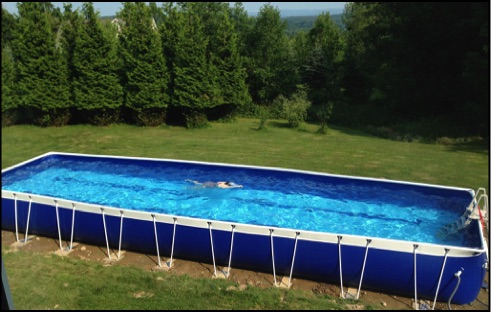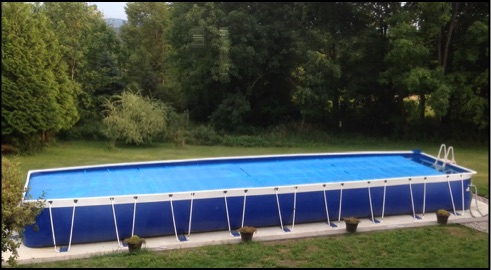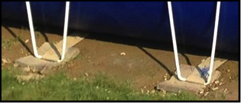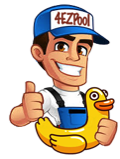

Proper Ground Prep Plays a Key Role
There is no way to predict what the ground will do when you place 30, 50, 100,000 pounds of water on top of it. A standard 12'x17' EZ Pool holds about 50,000 pounds of water. This is important to understand that your ground plays an important role in the life, use and function of your pool.
There are some very easy steps you can take that will help you not only make sure the ground does not imapct your pool - but does not erode over time and ultimately become dramatically out of level.
First let's understand the basic nature of water as it relates to your EZ Lap Pool.
Water Naturally Seeks a Round Shape
The greatest outward pressure of a lap pool is at the center. A lap pool is typically a rectangle, so the water in center of the pool pushes outward, trying to make the pool round. If the ground is loose soil or provides any give to the water pressure - the pool will bow outward.
Even if you place concrete pavers underneath the vertical supports, the ground underneath will give under the water pressure, causing the pavers to break in half.


Does it have to be on Concrete?
The above picture was provided by the same customer as the top picture. They discovered the pavers were cracking, and this was causing the pool to bow out. They elected instead to pour a concrete slab and place the pool on top. This of course, solved the problem. But that can be an expensive option.
It is important to remember that an EZ Pool can be placed on top of concrete, asphalt, bricks, dirt, grass, etc... So no it does not hurt the pool to be placed on any type of surface - the idea is let you know what can happen when you place the pool on a surface that can allow the pool to push into the ground. But at the end of the day, concrete is going to make sure the pool is level.
How about concrete and sand.
Sand is a horrible leveler. Some customers have tried to level the ground with sand, but this has no stability under pressure - even compacted sand. The pool supports will push right into sand, and over time water from the pool or rain will errode the sand away even more. However, sand is comfortable under foot.
So here is a great way to get you what you want and provide the pool what it needs - Create a Concrete Perimeter. This is much less expensive than pouring a complete concrete pad, will still providing the pool support you need on a long lap pool.
IMPORTANT: When creating a rigid perimeter for the pool frame, make sure The Perimeter is the Same Height as the Ground where the Pool is Resting. If the perimeter is higher than the ground this will damage the pool support flaps.
Plus, you can fill the interior of the perimeter with sand which is a very nice soft surface for the pool to be placed on. This type of combination is a little more money than just setting the pool up on the ground. But most people buying an EZ Lap Pool want to make sure they get the most out of their purchase.
In the case with this customer, he knew his ground was going to be an issue right from the start. He sought out our advice and followed it exactly to the letter. Now his pool is up, is straight and when those nasty gulf down pours flow through his area - he knows the ground will not play a factor with his EZ Lap Pool.
Remember, at the end of the day you want to enjoy your pool, swim in your own pool, exercise and relax in your own pool. Using this customer's yard as an example, a traditional in-ground pool would have been between $25,000 (fiberglass shell) to $40,000 (concrete). But with EZ Pool (and the concrete perimeter) he only spent $8,000.




















